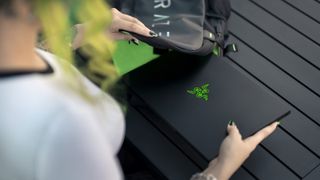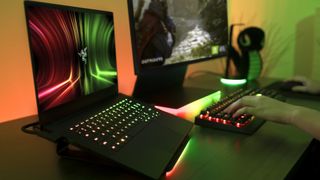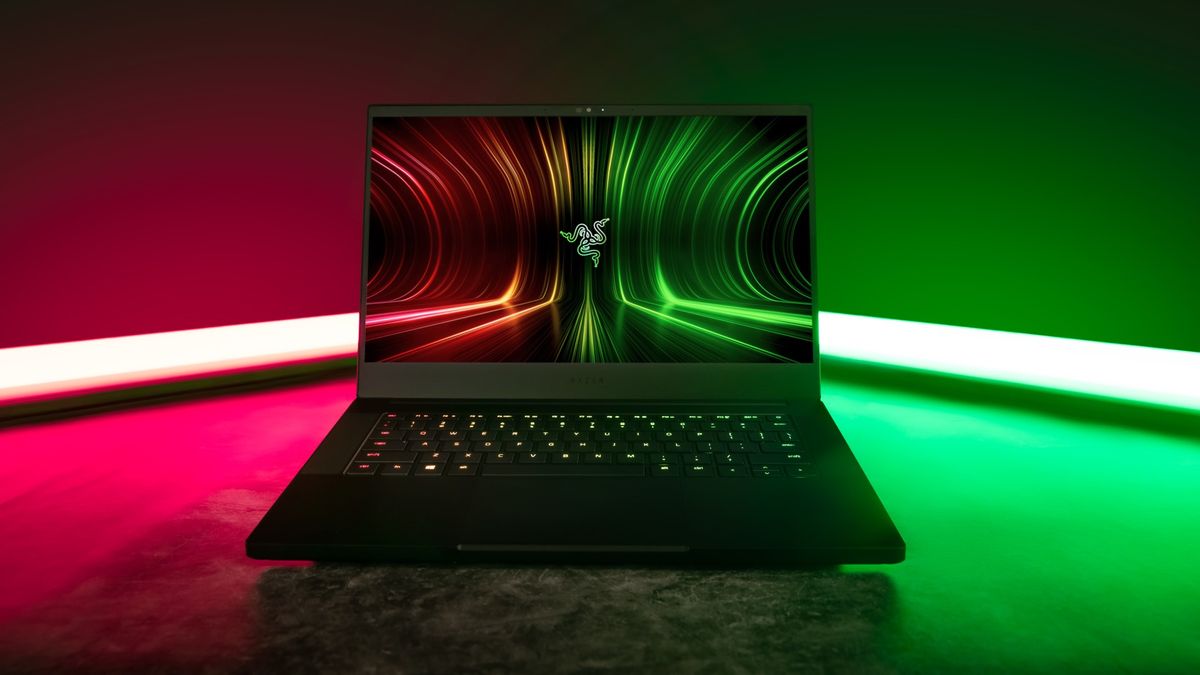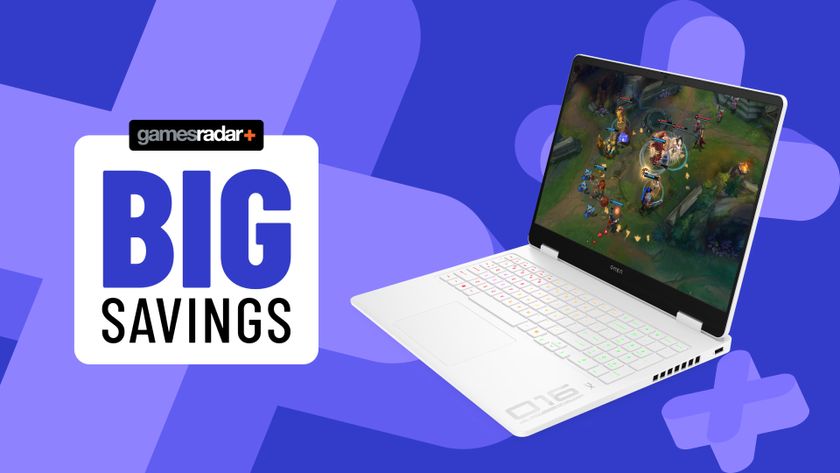12DOVE Verdict
A tremendous little gaming machine, that punches well above its diminutive stature - from power to price tag.
Pros
- +
Great component configuration
- +
Tangible benefits of Ryzen CPU
- +
Brilliantly compact, and quality Razer design and build...
Cons
- -
...but almost too small
- -
Gets hot
- -
Razer tax
Why you can trust 12DOVE
Update Oct 2023: We reviewed the latest Razer Blade 14 in October 2023, with improved RTX 40-Series graphics cards, a boosted 16:10 display, and AMD's Ryzen 9 7940HS processor. Check out our full Razer Blade 14 (2023) review for more.
The Razer Blade 14 looks to ride and extend the wave of popularity and demand for 14-inch, powerful gaming laptops. There's something about combining genuine gaming prowess and compact laptop design that a more 'regular' 15.6-inch laptop just can't quite nail.
And with a new generation of the best graphics card and the best CPUs for gaming now firmly here, the Razer Blade 14 steps forward to embrace the latest components in that smaller 14-inch chassis. At first, this just feels like a small Razer laptop - not dissimilar to the Blade 13, just something you can fling about with one hand - but it's more than that, and is definitely one of the smallest best gaming laptop contenders. And it's the first Razer laptop to mix gear from both Team Green and Team Red. It all sounds truly special, but there are a couple of caveats.
Design & features
These are the specs of the laptop sent into 12DOVE for review.
Processor: AMD Ryzen 9 5900HX
Graphics: Nvidia GeForce RTX 3080
Memory: 16GB DDR4 RAM
Display: 14-inch, 165Hz
Resolution: 2160 x 1440
Storage: 1TB PCIe M.2 SSD
Ports: 2 x USB 3.2 Type-A USBs; 2 x USB 3.2 Type-C USB (charging and Display Port); 1 x power port; 1 x HDMI 2.1; 1 x 3.5mm Headphone/Microphone combo jack
Connectivity: Wi-Fi 6E (802.11ax), Bluetooth 5.2
OS: Windows 10 Home
Dimensions: 0.66” x 8.66” x 12.59” (16.8mm x 220mm x 319.7mm)
Weight: 3.92 lbs (1.78 kg)
As I say, the Razer Blade 14 is indeed a bonafide, familiar-looking Razer laptop - just smol. And while the thin, light and chic matte black Razer design can't hide the sheer size of a 17-inch machine like the Razer Blade Pro 17, it somehow makes the Blade 14 feel even smaller than 14 inches in the hands.
It's incredible to think that there's so much oomph and beastly power in this tiny thing. On the chassis, there are compromises in the most basic of features - a lack of ethernet and display ports is a bit lame, for example, but a byproduct of the super slim and thin design language.
The USB-C port will, naturally, step in for the lack of a display port, and there are three regular USB ports to tide you over too, which is just about right. As are the usual Razer-quality touchpad and keyboard - though I'm sure the brand would be the first to say that the Blade 14 will only be better when teamed with a Razer keyboard or Razer mouse (the touchpad and keyboard are good for when you're using it for work on the move though, of course).
The final 'exterior' feature of note is the Razer Blade 14's screen. So, it's not an OLED screen, or touchscreen or anything, but it is a 14-inch, 1440p 165Hz panel. The former makes great use of the small chassis, really filling it out, while the latter two factors make for an excellently balanced display.
The 1440p resolution is one that can offer more than bog-standard Full HD, and has long been the sweet spot for PC gaming. This spec can really play nice with the components under the hood (more on them shortly), while the refresh rate is speedy without being too ridiculous. Razer (and plenty of other brands) often pack 300Hz panels which simply aren't required for the majority of gaming use and are also, inevitably, more expensive.

Firing the games to that display is a quality set of components that are poised beautifully to bring out the best out in each other. AMD's CPU and Nvidia's graphics work together with the screen to give a brilliant gaming experience. In the red corner, we have an AMD Ryzen 9 5900HX processor, and in the green corner, an Nvidia RTX 3080 graphics card, both supported by a 1TB SSD, and 16GB of RAM.
The storage and RAM are basically Razer's default choices for their premium laptops but the combination of an AMD CPU and an Nvidia GPU - a 3080 no less - is a tantalising prospect. More on the results later, but it does finally nod to a way that the price of such Razer Blades might be able to be held down, without compromising on performance wildly.
With more and more folks building the best gaming PCs out of a range of components from both sides of the divide, this move does seem to finally drag high-profile Blade laptops in line with that trend and the 2021 PC gaming industry.
Performance
How does the Razer Blade 14 (2021) fare on some industry tests?
Firestrike: 21130
Firestrike Extreme: 11573
Timespy: 9432
Port Royal: 5918
PCMark 10: 6792
PC Mark 10 Gaming Battery Test: 54 minutes
PC Mark 10 Battery Test: 6 hrs 2 mins, 6116
Cinebench CPU: Multi-core: 11,570cb; Single-core: 1,460cb
CrystalDiskMark: 3,570 MB/s read; 2,949 MB/s write
Tom Clancy's The Division 2: Ultra: 56 fps; High: 71 fps
Metro Exodus: RTX (ray-tracing on Ultra): 48 fps; High: 66 fps
Shadow of the Tomb Raider: Highest: 78 fps; High: 85 fps
Total War: Three Kingdoms: Ultra: 49 fps; High: 67 fps
If you're looking for a quick snapshot of how it performs, then that's easy; it runs like a dream, feels good to use, and chews through anything that's thrown at it.
While a lot has been said about stuffing the highly-rated RTX 3080 GPU into a laptop and watching it tear the world up, the reality hasn't been quite so clear-cut. However, the Razer Blade 14 seems about the perfect mix of everything you can get in a gaming laptop: combining an RTX 3080, a 1440p screen, and a new Ryzen CPU really does hit the spot.
My only main caveat is that I do - in gaming more than anything, predictably - find myself wanting a larger screen sometimes. The 14-inch panel is a marvel, particularly with that 2K res, but it does tread a fine line between 'just about big enough', and 'not big enough at all'. Though this will be tempered once you get used to it, and also being able to hook it up to a gaming monitor, of course.
As the benchmarks show in crude number terms, the Razer Blade 14, in this build, is a gaming beast. Being able to run Red Dead 2 on maximum settings and getting close to 60 fps in a 1440p resolution? That's excellent and it only takes some small adjustments to ensure you get over the 60 fps mark while maintaining high levels of graphical fidelity too.
It falls a bit shorter of the 60 fps mark on Metro Exodus with everything turned up to 11, but just tune that to High, or thereabouts, and you still get a smooth, beautiful experience across Russia's post-apocalyptic wasteland expanses.
While I expected the Ryzen CPU to absolutely eat up more processor-hungry applications and games, like Total War, it wasn't a silver bullet. Bump the resolution down to 1080p, and the framerate returns to the safety of 'north of 60 fps'.
Some more tinkering in games like this is required to adjust the settings perfectly which was something that caused my eyebrow to rise a little. Maybe this actually highlights a good point for a 1440p laptop; it still offers flexibility and you can always bump it down to 1080p - depending on whatever happens to be under the hood.

All in, the Blade 14 comfortably outperforms some other Razer Blade laptops we've tested like the Blade 15 Advanced and Razer Blade Pro 17, and I am, despite the smaller screen, generally, as happy gaming on the Blade 14 as I am on my ASUS ROG GA15 PC.
However, just to ensure all bases are covered, there are a couple of compromises to take note of. The primary one being the fact that it does run hot and loud, which is noticeable in every day use and sometimes, when resting your hands on it to play and use, very much worthy of attention! That said, I do find myself writing this in nearly every gaming laptop review these days. The vapor chamber cooling system does its best - and works, of course - but it's still a noticeable factor during use.
Also, while Razer claims the Blade 14 has up to 12-hours of battery life, our PC Mark 10 battery tests didn't get anywhere near this. There might be some more life you can squeeze out of it, particularly when not gaming, but this is a gaming beast so that's the way the majority of folks will be using it. And using it plugged in, at that.
The smaller form factor and screen mean you do forfeit some of the immersion (as much as you can get in laptops, I know) as the 14-inch display is, for lack of a better term, very small.
That being said, the screen itself is of a great standard and quality. The fast refresh rate is not ridiculous but high enough to give the 3080 plenty of headroom to boost the frame rates to super smooth and speedy levels, and the 2K resolution continues to be the sweet spot for maintaining excellent image quality alongside that speed.
Pictures are crisp, clear, and vibrant and the anti-glare surfacing genuinely works when playing in bright light next to a window or similar (handy to know for those who are taking the 14-inch laptop out and about for work too).

Overall - should you buy it?
This is a tremendous little gaming machine, no doubt. It's got the right blend of components from the main players, the right blend of the right level of components, and squeezing it into a 14-inch laptop with such success is impressive.
While the Blade 14 finds itself on the cusp of acceptability in terms of compact gaming laptops (this is a screen size that, in reality, is only just big enough to play on) it has married said screen with some excellent components that will make it shine. Those looking for a premium gaming laptop that will crunch through anything, while also offering a great machine for home and office use, need look no further.
The one major qualm we have, predictably, is the price tag. It's the most attractive 14-inch gaming laptop package going but it is so expensive. Our model pushes the $3,000 mark ($2,800 to be precise), which just feels a bit too much - even for Razer. While you get the punch for your money, you might not get the actual bang - in terms of screen size and space. At this size, we'd be more tempted with the RTX 3070 model (around the $2,300 mark) or even the RTX 3060 model (around the $1,800 mark). It might even be worth looking at the Blade 15 range to ensure you get a bit more screen real estate.
This is a machine that feels like it's got the right mix of everything, and that's where the Blade 14 proves itself. Regardless of actual size, those looking for a really well-put-together RTX 3080 laptop are likely to find that this is just the ticket.
Rob is the Deputy Editor of sister site, TechRadar Gaming, and has been in the games and tech industry for years. Prior to a recent stint as Gaming Editor at WePC, Rob was the Commissioning Editor for Hardware at 12DOVE, and was on the hardware team for more than four years, since its inception in late 2018. He is also a writer on games and has had work published over the last six years or so at the likes of Eurogamer, RPS, PCGN, and more. He is also a qualified landscape and garden designer, so does that in his spare time, while he is also an expert on the virtual landscapes and environments of games and loves to write about them too, including in an upcoming book on the topic!














